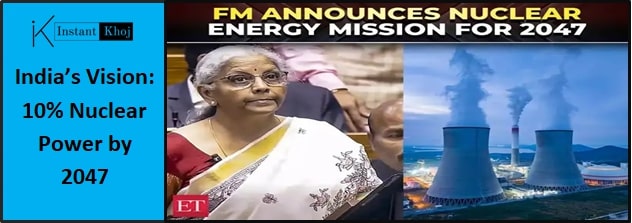Introduction
India’s energy sector is undergoing a major transformation as the country balances rapid economic growth with its climate commitments. With electricity demand expected to more than double by 2047, policymakers are increasingly turning to nuclear energy as a clean, reliable, and scalable option. The government has outlined a plan to ensure that nuclear power contributes about 10% of India’s electricity generation by 2047, positioning it as a vital part of the country’s long-term energy mix.
Background: Current Energy Mix and Nuclear’s Role
At present, India relies heavily on coal, which still supplies around 70% of the country’s electricity. Renewables like solar and wind are expanding quickly, but nuclear remains a relatively small player—providing only about 3% of electricity through 24 reactors with a combined capacity of 8.18 GW. While modest compared to coal and renewables, nuclear offers a stable baseload option that complements intermittent sources like wind and solar.
Policy Support and the 2047 Target
India’s nuclear expansion is supported by the India Nuclear Power Programme and integrated into broader national strategies such as the National Electricity Plan and net-zero target by 2070. The government has emphasized:
- Fleet-mode construction of indigenous 700 MW Pressurized Heavy Water Reactors (PHWRs).
- Public–private partnerships in new reactor projects.
- International collaboration with France, Russia, and the United States for advanced technologies.
- Financial backing through the ₹76,000 crore domestic reactor construction package announced in 2022.
These measures are designed to accelerate construction timelines, reduce costs, and ensure energy security.
Key Projects in the Pipeline
Several new projects form the backbone of India’s nuclear expansion:
- Kudankulam (Tamil Nadu): Six reactors, with two operational and more under construction in collaboration with Russia.
- Jaitapur (Maharashtra): Proposed site for six French-designed EPRs, which would make it the world’s largest nuclear plant if completed. Currently at the clearance and preparatory stage.
- Mahi Banswara (Rajasthan): Four indigenous PHWRs approved and moving toward construction.
- Gorakhpur Haryana Anu Vidyut Pariyojana (GHAVP): Two 700 MW PHWRs under construction.
- Kaiga (Karnataka): Planned expansion with indigenous reactors.
Together, these projects are expected to significantly raise installed capacity and push India closer to its 2047 goal.
Technological Advancements
India continues to rely on its proven PHWR technology while also pursuing:
- Light Water Reactors (LWRs): In partnership with Russia and the U.S.
- Fast Breeder Reactors (FBRs): To maximize fuel efficiency and use of thorium, where India has abundant reserves.
- Small Modular Reactors (SMRs): Being studied as a flexible and potentially cost-effective option for the future.
These innovations aim to diversify India’s nuclear portfolio while improving safety and efficiency.
Strategic Importance of Nuclear Energy
Expanding nuclear capacity carries both environmental and strategic benefits:
- Clean Energy: Nuclear produces almost no carbon emissions during operation, helping India meet its climate targets.
- Energy Security: Domestic production reduces dependence on imported fossil fuels.
- Grid Stability: Nuclear provides round-the-clock baseload power, complementing renewables.
- Economic Growth: Large-scale projects create jobs, stimulate local economies, and attract foreign investment.
Challenges on the Road Ahead
Despite its promise, India’s nuclear sector faces obstacles:
- Long Construction Timelines: Projects like Kudankulam and Jaitapur have experienced significant delays.
- High Costs: Nuclear plants require heavy upfront investment compared to renewables.
- Public Concerns: Safety and environmental issues remain sensitive, particularly after Fukushima.
- Technology and Supply Chains: India still relies on international partnerships for advanced reactor designs and nuclear fuel.
Addressing these challenges will be critical if India is to meet its 2047 target.
Expert Views and Outlook
Experts see nuclear as an essential but realistically modest contributor to India’s clean energy transition. While the 10% by 2047 target is achievable, its success will depend on faster clearances, steady financing, and efficient project execution. Many observers believe nuclear should complement, not compete with, renewables—offering balance and reliability in a diversified energy mix.
Conclusion
India’s plan to raise nuclear’s share to 10% of electricity generation by 2047 is both ambitious and strategic. It reflects the country’s commitment to energy security, clean growth, and global climate goals. Success will require overcoming technological, financial, and regulatory hurdles, but if delivered, nuclear power could shift from a supporting role to a backbone of India’s sustainable energy future.
Sources
- Ministry of Power, Government of India
- Nuclear Power Corporation of India Limited (NPCIL)
- Department of Atomic Energy (DAE)
- Semicon India & related policy documents
Disclaimer
This article is based on publicly available information as of August 2025. Readers are advised to consult official government sources such as the Department of Atomic Energy (DAE) and NPCIL for the latest updates on India’s nuclear program.
Read more articles like this — Click here to explore now




